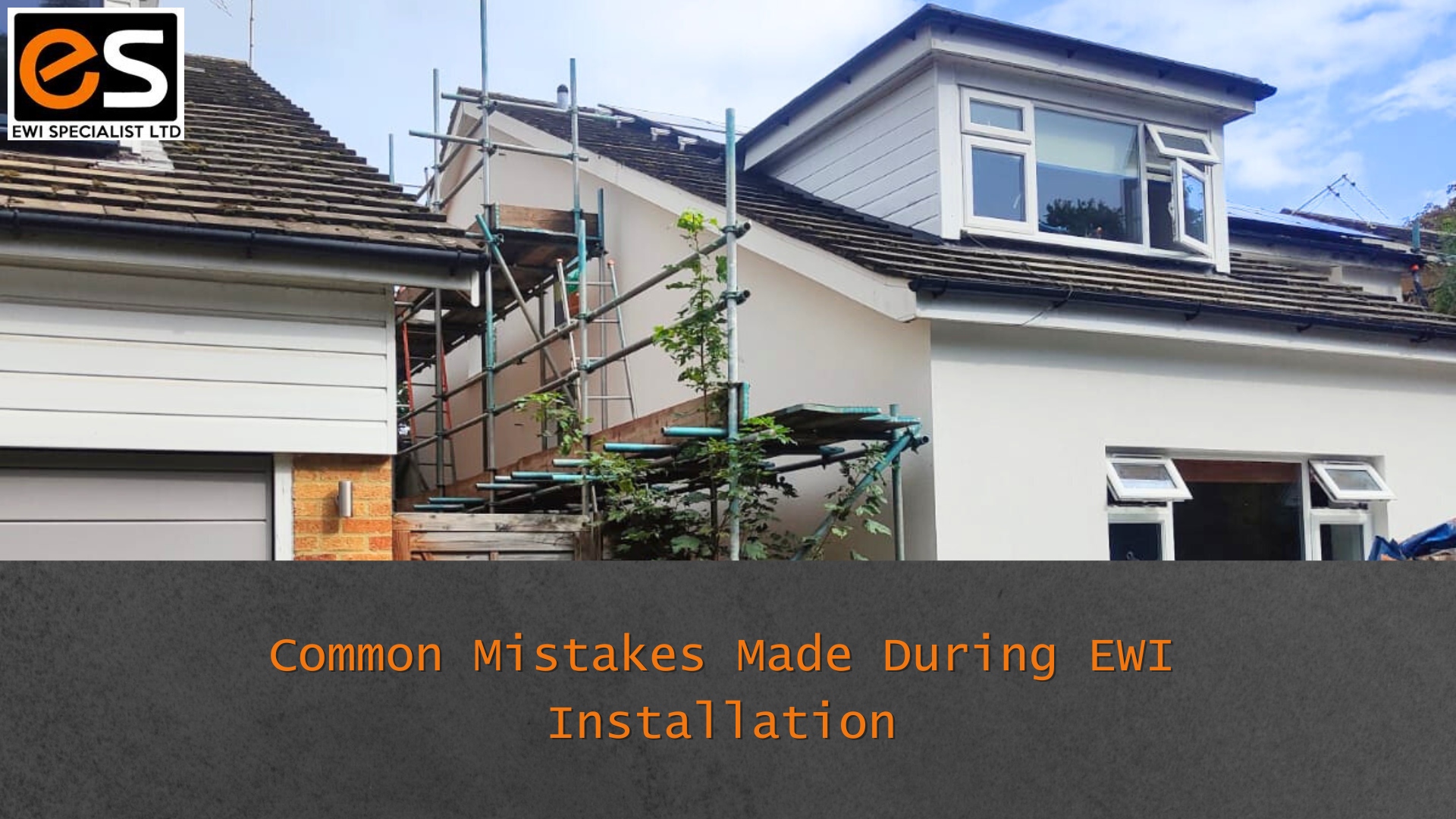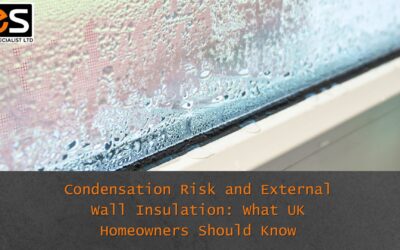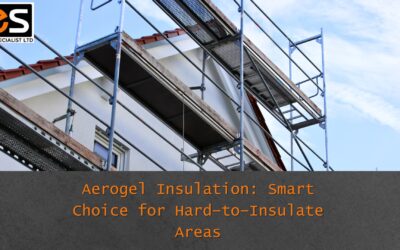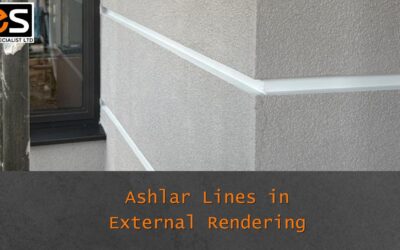When installed correctly, external wall insulation (EWI) can reduce your energy bills and completely transform the way your home looks, feels, and performs. From keeping the heat in during winter to giving your property a crisp, modern finish, it’s one of the most effective ways to upgrade your home.
But here’s the catch: EWI installation is not just about sticking insulation boards to walls. Small oversights or rushed workmanship during installation can quietly lead to much bigger issues down the line, we’re talking about cold spots, damp patches, unsightly cracks, and insulation that doesn’t do its job.
In this guide, we’re sharing the most common mistakes we’ve seen on EWI projects and more importantly, how to avoid them. Whether you’re a homeowner considering EWI or a contractor aiming to sharpen up best practice, this is your go-to checklist for getting EWI right.
Content Page
- Common Mistakes Made During External Wall Insulation Installation
- Surface Preparation & Product Handling
- Insulation Boards Installation
- Window & Door Openings: Common Mistakes
- Additional Fixing and Finishing Issues
- How to Ensure a Lasting EWI System
Common Mistakes Made During External Wall Insulation Installation
EWI is one of the most effective ways to improve home comfort, reduce energy bills, and protect the exterior of your property. But like any construction system, it must be installed properly to deliver the full benefits.
Over the years, we’ve come across a wide range of avoidable mistakes, some minor, others more serious, and each one can impact the long-term performance and appearance of the system. That’s why we’ve put together this guide.
Below, we walk you through the most common EWI installation errors, explain why they matter, and show how to avoid them, so you can ensure your project stands the test of time.
Surface Preparation & Product Handling
Mistake 1: Skipping primer before applying insulation boards
Failing to apply primer to the substrate before fixing insulation boards is a common oversight. Primer promotes better adhesion between the wall and the adhesive. Skipping this step can weaken the bond, reducing the strength and longevity of the system. In more severe cases, boards may eventually detach from the wall.
Fix: Always apply the appropriate primer to the substrate as recommended by the system manufacturer to ensure a strong and lasting bond.
Mistake 2: Not rubbing down or leveling the insulation boards
Once the insulation boards are fixed, the surface may have minor uneven areas or slight misalignments. If these aren’t smoothed out before applying the basecoat and mesh, it can lead to poor adhesion and an uneven render finish.
Fix: Lightly sand or rub down EPS boards after installation to achieve a smooth, level surface ready for reinforcement and rendering.
Mistake 3: Incorrect boarding pattern
Installing insulation boards in straight, aligned rows without staggering joints weakens the system. This layout creates continuous vertical or horizontal seams, increasing the risk of thermal bridging, cracking, and reduced system stability.
Fix: Always install boards in a staggered pattern (like brickwork), with vertical joints offset by at least half a board. Avoid four board corners meeting at a single point to maintain structural integrity and reduce the risk of cracking.
Mistake 4: Poor on-site storage of materials
Materials such as EPS boards, basecoats, mesh, primers, and renders are vulnerable to moisture, heat, and prolonged sun exposure. Leaving them uncovered on-site, especially in damp or rainy conditions, can degrade product performance before installation even begins.
Fix: Store all materials on raised platforms or pallets, covered and protected from the weather, following the manufacturer’s storage recommendations.
Insulation Boards Installation
Mistake 5: Using ‘dot only’ adhesive method
Applying adhesive only in small dots on the back of insulation boards is incorrect and risky. This method fails to provide full surface coverage, which can lead to air gaps behind the boards, poor adhesion, and ultimately, system failure.
Fix: Always use the correct “dot and dab” technique: apply adhesive around the perimeter and in central spots to ensure secure and even bonding.
📸 Photo: Correct use of the “dot and dab” method for even adhesion and ventilation control.
Mistake 6: Failing to fill gaps between insulation boards
Leaving gaps between insulation boards creates thermal bridges, allowing cold air to pass through and reducing the overall energy efficiency of the system. These gaps can also allow moisture to enter, increasing the risk of condensation and mould growth.
Fix: Fill all gaps between boards using offcuts of the same insulation material or suitable expanding foam. Avoid leaving any exposed joints.
Mistake 7: Filling gaps with basecoat instead of insulation
Some installers try to fill board gaps using basecoat material, but this doesn’t offer the same insulating properties. It creates weak points in the system, leading to cold spots and reduced thermal performance.
Fix: Never use basecoat to fill insulation gaps. Instead, use correctly cut offcuts or expanding foam designed for EWI systems.
📸 Photo: Properly insulated window reveal with sealed EPS joints to prevent thermal bridging.
Mistake 8: Using only adhesive or only mechanical fixings
Relying solely on adhesive or mechanical fixings can compromise the strength of the EWI system. Adhesive alone may not hold in uneven or weather-exposed areas, while mechanical fixings alone may not seal gaps or prevent movement.
Fix: Always combine both adhesive and mechanical fixings for secure, long-lasting installation, especially important for uneven walls or multi-storey buildings.
Window & Door Openings
Mistake 9: No diagonal reinforcement mesh around openings
Corners around windows and doors are natural stress points in any external wall insulation system. Without diagonal mesh reinforcement across these areas, cracks are much more likely to form over time. These cracks can compromise the render, allowing moisture to penetrate and reducing the system’s durability.
Fix: Always install reinforcement mesh diagonally at 45° angles at each corner of windows and doors to strengthen the system and prevent cracking.
📸 Photos: Diagonal mesh correctly applied at window corners to reinforce stress points.
📸 Photo: Full property view showing diagonal mesh around all openings for crack prevention.
Mistake 10: Incorrectly shaped insulation boards around openings
Cutting insulation boards into simple rectangular strips to fit around doors or windows creates weak points. This method increases the likelihood of cracking at joints near openings and reduces system integrity.
Fix: Use L-shaped cuts around window and door corners to avoid vertical joints at stress points. Always stagger the joints to enhance strength and continuity.
📸 Photo: L-shaped insulation cuts around windows for enhanced structural integrity.
Mistake 11: No insulation in reveals (window and door recesses)
Leaving window and door reveals uninsulated is a major error. These areas are especially prone to thermal bridging, which can cause cold spots on interior walls, increase heat loss, and promote condensation and mould.
Fix: Always insulate window and door reveals as part of the system. This ensures the thermal envelope is continuous and effective.
📸 Photo: Insulated window reveal using EPS boards to eliminate cold spots.
Mistake 12: Skipping beading or using the wrong type
Beads (corner beads, stop beads, and drip beads) play a critical role in reinforcing and finishing the EWI system. Omitting them or using the wrong type can result in poorly defined edges, water penetration, and cracks forming over time, especially around vulnerable points like corners and reveals.
Fix: Use the correct type of beading in all required areas, installed according to manufacturer guidance. Beads help shape, strengthen, and protect the render where it needs it most.
Additional Fixing and Finishing Issues
Mistake 13: Skipping insulation at the plinth area
The base of the building, also known as the plinth, is a common area where insulation is forgotten or poorly executed. This oversight creates a thermal bridge at floor level, leading to significant heat loss and increased risk of damp and mould at the bottom of internal walls.
Fix: Always include dedicated plinth insulation boards that are moisture-resistant and suited for ground contact. Follow the manufacturer’s details to ensure proper drainage and protection from splashback and rising damp.
Mistake 14: Poorly extended ventilation ducts
Failing to correctly extend and seal ventilation ducts through the insulation layer is a frequent installation flaw. Unsealed or loosely fitted vents allow rainwater and moisture-laden air to get behind the insulation, threatening both the adhesive bond and the integrity of the render.
Fix: All vents should be properly extended using rigid sleeves and securely sealed where they pass through the insulation. Ensure any plastic ducting is embedded into the basecoat and mesh layer to prevent future movement or leaks.
Mistake 15: Extending pipes from the outside instead of the inside
When drainage or extraction pipes are extended externally, rather than through the internal system, they often rely on surface-mounted sealing, which is more vulnerable to weathering, movement, and eventual failure. This can allow water to penetrate behind the insulation system.
Fix: Plan pipework routing early in the project. Wherever possible, extend all pipes and ductwork from the inside, passing them through the insulation layer with a sealed finish to maintain the waterproofing and insulation performance.
How to Ensure a Lasting EWI System
These mistakes are more common than you might expect, and while some may seem minor, they can lead to serious issues over time. Whether you’re preparing for an upcoming EWI project or evaluating the quality of existing work, knowing what to watch out for is key to long-term performance and peace of mind.
By avoiding the errors outlined in this guide, you can ensure that your external wall insulation system delivers on its promise: energy efficiency, comfort, and a flawless finish that lasts.
Need expert help?
Our experienced team provides trusted advice, skilled installation, and dependable service.
Get in touch for a free quote, or try our new EWI cost calculator to estimate your project today.











